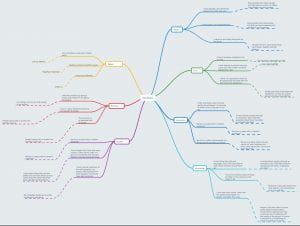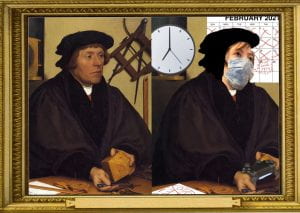What can we learn from the past and why does it matter to us today? That is the question we set out to answer on February 1, 2021. This post is to reflect and document the journey we ventured out on to answer this question. Over one month we embarked on an adventure that taught us about our past and how it impacts us. We covered many interesting topics including Christianity and the Crusades. This study prepared us for the stressful yet exiting task of crafting a virtual museum. This museum would showcase our growth as learners and introduce the concept of worldview to our audience. But before the time comes to reveal our creation, we must explain how we got there.
We started this project on February 1, 2021. I missed the first day, so I had some catching up to do. On day two, we started to learn about what makes a good museum. We used google arts and culture to explore two sets of museums. Each set had three museums in them. One set focused on the layout and design of the museum itself, and the other taught us about the content, and what we were going to be doing with our museum. For this, we were tasked its creating a mind map of what we learned. This is mine.
We went for 7 days and 7 nights learning and expanding our knowledge about museums and worldview. One thing we created was a worldview mind map. Mine looked like this.
Then on Monday, February 8, it was due. Milestone 2, a collage of photos that we though represented our worldview. We then wrote a paragraph or two to explain how each image represented our worldview. My original collage looked like this.
Next came milestone 3. This milestone was an in-class test. We were tasked to write a essagraph about a historically significant event, and how that event connected to one aspect of our worldview. We were told to write about only one aspect of worldview right before the test, so we had little time to prepare. I started out writing about the invention of the clock, and how time structures our lives in many ways, and when I realized that time and the way it structures our lives was around long before the invention of the clock. But I kept going. At the end of the test, I had written an essagraph about time and how it governs our lives. But I couldn’t connect it to a medieval or Renaissance event. I knew this coming out of the test, and my thoughts were confirmed when we received feedback. This was an important milestone because the topic we wrote about on our test determined our groups for the rest of the project. This milestone also taught me that not everything goes my way, and learning and growing from my mistakes are more important than crumbling from the failure.
On February 12, we started on one of our most influential stepping stones. We were tasked with writing a conclusion about the worldview aspect we were assigned based on the topic we wrote about in our test. My group was time, and my conclusion looked like this.
My worldview aspect of time has been developed by the concept of time. I know that sounds obvious but hear me out. My entire life is based off of time, My day is based off time, my week, my month, my year, my life. We plan things based off numbers on a screen, in a circle with spinning hands. This dates back to the invention of the clock in 1094 by Su Song. This allowed the modern world to function and be structured in that way it is, and our lives to be structured in the way it is. This allowed the renaissance people to structure their lives around more then just the wax and wane of the sun. It allowed them to plan their lives to a much smaller decimal point. And that is how our world function even today. We time world records where even a 30th of a second can make all the difference. This affects things like how long we cook our food to how long we have until a meeting. Everything, and I mean everything is formulated around time. Without time, our world as we know it would collapse.
Then, over the weekend, we perfected this to become an argument. We made it a quality piece of writing. I was pretty proud of the conclusion that I wrote, so I didn’t change that much when it came to my argument. Mine looked like this.
Time is the most logical choice for the 2021 worldview aspect election. Here’s why. My entire life is based off of time, my day is based off time, my week, my month, my year, my life. Our lives are governed by time. We live our lives to the tick of a clock. We plan things based off numbers on a screen, in a circle with spinning hands. This dates back to the invention of the clock in 1094 by Su Song. This allowed the modern world to function and be structured in the way it is, and our lives to be structured in the way it is. This allowed the Renaissance people to structure their lives around more then just the wax and wane of the sun. It allowed them to plan their lives to a much smaller decimal point, and that is how our world functions still today. We time world records where even a 30th of a second can make all the difference. This affects things like how long we cook our food to how long we have until a meeting. Everything, and I mean everything is formulated around time. Without time, our world as we know it would collapse.
I know. Basically the same thing. These stepping stones were important because they became the artists statements that would play when you looked at someones painting in the museum.
Now for the thing that you’ve all been waiting for. The art. The actual thing we are putting in the museum. For our art, we were tasked with finding a renaissance or medieval painting that represented the renaissance or medieval view on our aspect of worldview. We were then tasked with photoshopping our face and some other objects into the shot to represent the current view of our worldview aspect. My final product looked like this.
Then, over the course of the next few weeks, we created our virtual museum. We were assigned roles in our worldview aspect groups, each doing a different thing. There were 6 main roles. The techie, that made the museum on the platform, art steps, the art designer, who created the frames and put everyone’s art into them, the room designer, who designed our section of the museum, the writer, who wrote the guided tour, the DRI,(directly responsible individual)who organized everyone, and flex, the person who did one small part of each role. With everyone in these roles, we put together our museum.
How does this museum answer the driving question? Well, I don’t think that the museum itself that answered the driving question, I think it was the learning we did along the way. We can learn lots of things from the past. Thing such as feudalism, and how much peoples lives revolved around thing that we don’t think that much about today. These things matter in many ways, including how our lives are still structured today by things that were established way before even our great-great-great-grandparents were born.
Responding to Texts: I think that I did pretty well on this competency. I think that I have learned a lot about what texts are trying to tell the audience, and I think I did pretty well with responding to the messages embedded in the texts.
Empowered Learner: I think that I did the really well, because I am pretty proud of the photoshop that I did for my meme, and I really enjoyed using SuperimposeX.
Establish Historical Significance: I think that I demonstrated this competency really well in milestone 3, even though I didn’t connect my worldview aspect to a certain event. I think that I did this well because I can look through most of the worldview aspects and understand a lot of the deeper meaning, and how it connects to our past.
In conclusion, I think that I did pretty okay on this project. I had a lot of fun, especially closer to the end, but I had a hard time finding motivation at the start. This project taught me a lot about the past, and I think that it had some important things to my history, and how developments from way back when impact my life even today. I also think that it had a lot in common with our last project, which also taught me a lot. I think that I would have had a lot more success if I had incorporated the numerous skills I learned in that project.
Here is a link to the museum, and here is a link to the companion book that our collages are in.
See you all in the next reflection.





March 28, 2021 at 12:49 am
Wow! Lots of learning here. What do you think was the most surprising thing you learned? Thank you for sharing your thoughts!